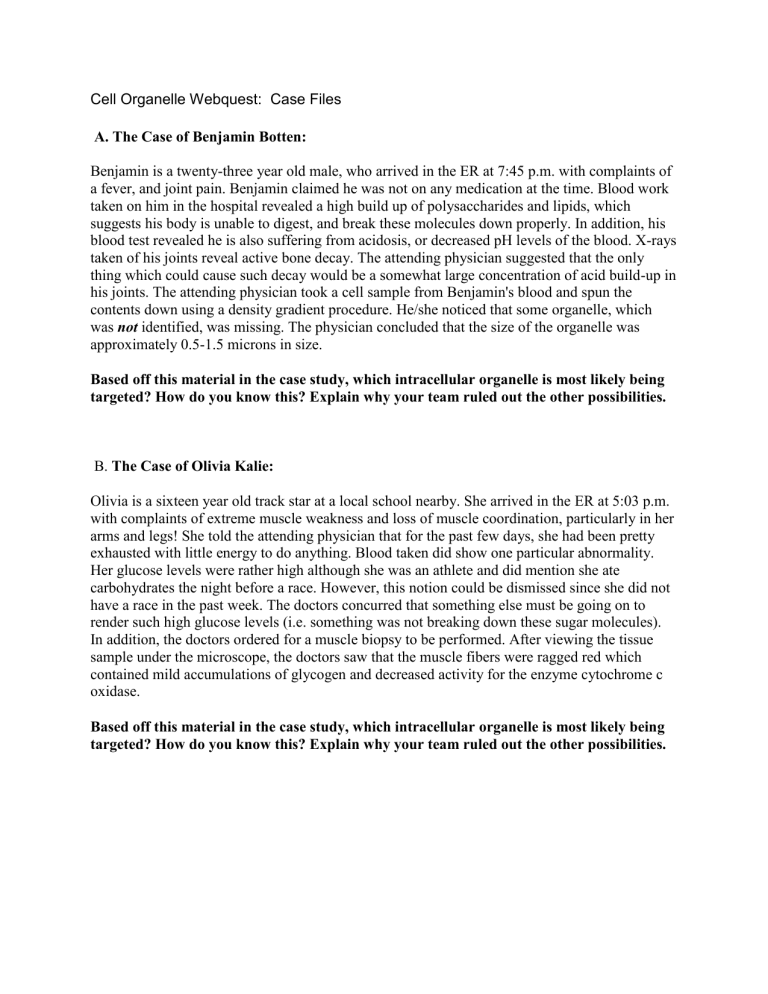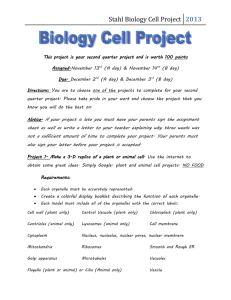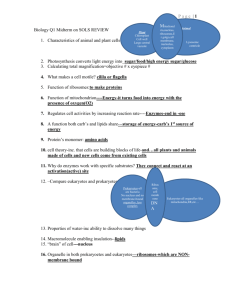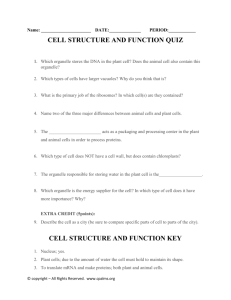Cell Organelle Webquest: Case Files

Cell Organelle Webquest: Case Files
A. The Case of Benjamin Botten:
Benjamin is a twenty-three year old male, who arrived in the ER at 7:45 p.m. with complaints of a fever, and joint pain. Benjamin claimed he was not on any medication at the time. Blood work taken on him in the hospital revealed a high build up of polysaccharides and lipids, which suggests his body is unable to digest, and break these molecules down properly. In addition, his blood test revealed he is also suffering from acidosis, or decreased pH levels of the blood. X-rays taken of his joints reveal active bone decay. The attending physician suggested that the only thing which could cause such decay would be a somewhat large concentration of acid build-up in his joints. The attending physician took a cell sample from Benjamin's blood and spun the contents down using a density gradient procedure. He/she noticed that some organelle, which was not identified, was missing. The physician concluded that the size of the organelle was approximately 0.5-1.5 microns in size.
Based off this material in the case study, which intracellular organelle is most likely being targeted? How do you know this? Explain why your team ruled out the other possibilities.
B. The Case of Olivia Kalie:
Olivia is a sixteen year old track star at a local school nearby. She arrived in the ER at 5:03 p.m. with complaints of extreme muscle weakness and loss of muscle coordination, particularly in her arms and legs! She told the attending physician that for the past few days, she had been pretty exhausted with little energy to do anything. Blood taken did show one particular abnormality.
Her glucose levels were rather high although she was an athlete and did mention she ate carbohydrates the night before a race. However, this notion could be dismissed since she did not have a race in the past week. The doctors concurred that something else must be going on to render such high glucose levels (i.e. something was not breaking down these sugar molecules).
In addition, the doctors ordered for a muscle biopsy to be performed. After viewing the tissue sample under the microscope, the doctors saw that the muscle fibers were ragged red which contained mild accumulations of glycogen and decreased activity for the enzyme cytochrome c oxidase.
Based off this material in the case study, which intracellular organelle is most likely being targeted? How do you know this? Explain why your team ruled out the other possibilities.
C. The Case of Frank Rentz:
Frank is a fifty year old male, who arrived in the ER at 6:04 a.m. with severe indigestion. The attending physician did blood work and found no abnormalities with it. An X-ray of his abdomen suggested that Franks body is unable to digest his food. The attending physician suggested this could be due to the inability of the intestinal cells to secrete the needed enzymes and bile salts into the intestinal cavity. The doctors performed the same density gradient procedure, and found that an organelle approximately 2500 nanometers in width was missing.
Based off this material in the case study, which intracellular organelle is most likely being targeted? How do you know this? Explain why your team ruled out the other possibilities.
D. The Case of Mary Streaver:
Mary is a fifty-five year old female, who arrived in the ER at 4:35 p.m. with complaints of severe fever and pain. The attending physician took blood work and revealed that there was a high concentration of oxidative enzymes in the blood such as catalase, D-amino acid oxidase, and uric acid oxidase. In addition, there were relatively high levels of fatty acids in the blood, which the physician suggested they were not being properly metabolized. A density gradient procedure found that an organelle approximately 0.5 microns in diameter was missing. The physician also diagnosed Mary with having gout in the joints in her hands and feet, a condition which is caused by the accumulation of uric acid. That same night around 11:00 p.m., Mary began to lose feeling in her lower back. The doctors performed a routine spinal tap (ST) to see if there was an infection in her cerebral spinal fluid. This test turned out to be negative; however, the attending physician did take a biopsy which revealed the nerve cells in Marys back were not producing enough myelin, a dielectric material needed for proper nervous system signaling.
Based off this material in the case study, which intracellular organelle is most likely being targeted? How do you know this? Explain why your team ruled out the other possibilities.







